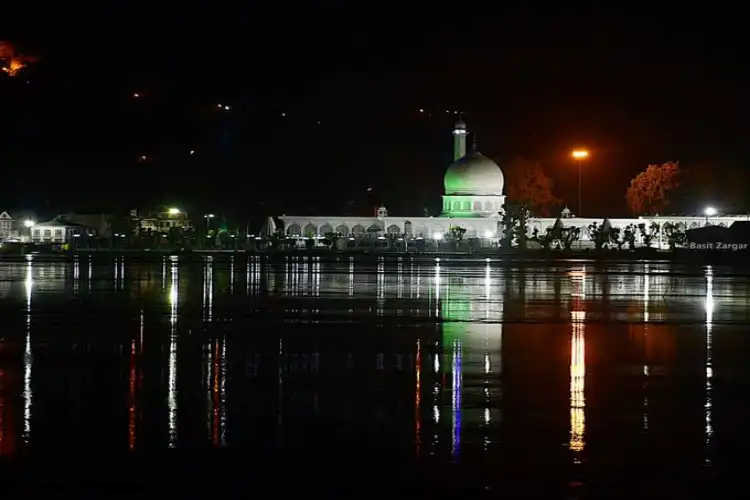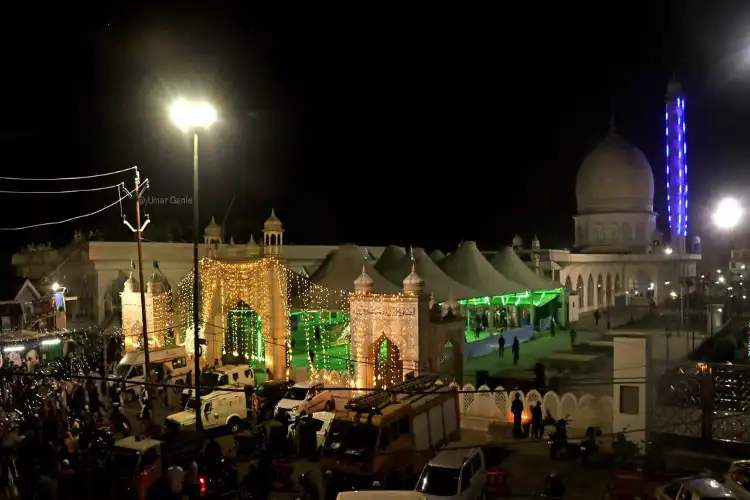
Ehsan Fazili/Srinagar
Over one lakh devotees are likely to converge at the Hazratbal shrine on the banks of Dal Lake on the occasion of Eid-e-Milad un Nabi on Sunday for prayers and most importantly for deedar (view) of Moi-e-Muqqadas, the Holy relic of the Prophet Muhammad on his birth anniversary.
A large number of devotees spent time in the shrine for Meelad shab and a late night Namaz on Saturday. Sunday will see Muslims offering five times congregational namaz. The holy relic is also displayed on the occasions of Meraj-e-Alam and Urs of four Caliphs.
The Holy relic – a strand of Prophet’s hair – kept in a glass case, will also be displayed for the deedar on Thursday night and Friday after Milad. It was recently that authorities lifted restrictions on the night-long prayers on the Thursday-Friday due to the Covid protocol.
It’s after three years of restrictions (due to political reasons and Covid) that Hazratbal will see a sea of devotees offering prayers. The J&K Waqf Board under Dr Darakhshan Andrabi said all arrangements have been made for the convenience of pilgrims. The Wakf board will take out a procession in the city on the occasion.
“Facilities including water, electricity, sanitation have been provided, while 252 latest washrooms with hot and cold water” have been set up by the Wakf Board, said Fayaz Ahmad Bhat, Administrator Wakf Board. The Traffic Police has also issued a plan for the smooth movement of traffic to and from the Hazratbal Dargah from the city center.
The relic has an interesting history; it was brought by Syed Abdullah Madani, a descendant of the Prophet, from the holy city of Madina, Saudi Arabia, who settled in Bijapur, Karnataka during the Mughal rule in 1635.
A video of Hazratbal shrine posted by a senior IPS officer Sujit Kumar on Twitter:
Eid milad ul Nabi mubarak ,
— Sujit Kumar Singh, IPS (@sujitpchauhan) October 8, 2022
Duaon kee raat mubarak #hazratbal#EidMiladunNabi #EidMiladunNabi #EidMiladunNabiMubarak pic.twitter.com/I2hnOKRpw0
After his death, his son Syed Hameed inherited the relic. After the Mughals conquered the region and they took away Syed Hameed's estates he passed on the relic to Khwaja Nooruddin Ishbari, a leading businessman from Kashmir.
However, Emperor Aurangzeb came to know about it and seized it. He sent it to the shrine of Moinuddin Chishti at Ajmer, Rajasthan. Within nine days he changed his mind and returned the relic to Ishbari.
Ishbari, who had been jailed, had died in the meanwhile. The relic was brought to Kashmir along with Ishbari’s body in 1700. Ishbari’s daughter Inayat Begum became the custodian of the relic. She first kept it at the shrine of Khwaja Baha-ud-Din Naqshbandi and later shifted to Hazratbal.
Ever since the relic was brought to Kashmir, the male descendants of Inayat Begum, known as the Banday family are the custodians of the relic.
The present structure of the Hazratbal shrine was constructed between 1968 and 1979 under the supervision of J&K Muslim Auqaf Trust’s Sheikh Mohammad Abdullah.
Besides being the most revered shrine in Kashmir, Hazratbal was used by the National Conference for political gains also.
 A view of the entrance of Hazratbal Shrine (Courtesy: Twitter of Kashmir Today)
A view of the entrance of Hazratbal Shrine (Courtesy: Twitter of Kashmir Today)
On the morning of December 27, 1963, people in Kashmir rose to the shocking news of the missing of Moi-e-Muqqadas (Holy relic) from the Hazratbal shrine. “The shocking news caused widespread bereavement and anguish among people who in no time poured on the streets in tens of thousands — barefooted, bareheaded, wailing and grieving, and shouting the slogan, Moi-e-Rasool-e-paak ko Wapas karo ae zalimo (O, Tormentors! Return the sacred hair of the Holy Messenger) and chanting ‘Allah-o-Akbar (Allah is Great) and Ya Rasool Allah (O, Messenger of Allah),” writes Khalid Bashir autor of Kashmir: Exposing the Myth behind narrative in an article.
Prime Minister Jawaharlal Nehru deputed several leaders and officials to help the State Government handle the extraordinary situation.
Over a week later on January 4, 1964, it was announced that the holy relic has been recovered and its authenticity verified by the caretakers. Yet old-timers recall it took over a month to restore normalcy in the valley. The peace was restored when a group of leaders headed by spiritual personality, Syed Meerak Shah Kashani again vouched for the authenticity of the recovered relic.
During the recent phase of insurgency on October 14, 1993, the security forces laid a siege around the shrine where more than 60 militants and hostages were trapped. The siege ended 32 later after an agreement between the holed-in militants and the government.
ALSO READ: Srinagar's Kulsuma mothers autistic children
Three years later, 22 JKLF terrorists were killed in an encounter close by as they were planning to re-enter the shrine. The JKLF insurgents who had been ousted from the shrine in 1993 had made their headquarters nearby and according to police; they were planning to take control of the shrine once again.
